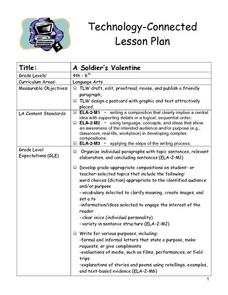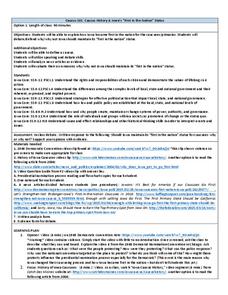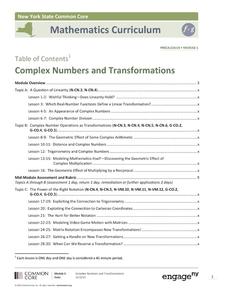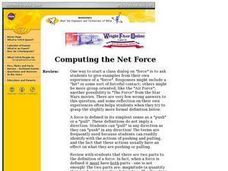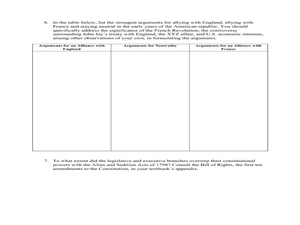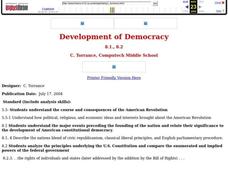Curated OER
Darwin, Politics, and Religion
Students gain an understanding of the Darwinian theory of evolution, examine how Darwin's theory has been adopted by ruling elites in order to justify their position in power, compare religious and historical responses to Darwin's...
Curated OER
The Language of Deception
Learners explore informative, expressive, directive and performative languages and discuss examples of each. In groups, students research the types of languages, their effectiveness in communicating truth, needs and desires. Learners...
Curated OER
A Soldier's Valentine
Students create Valentine's for soldiers in Iraq. They review how to write a friendly paragraph and discuss the military and duties of soldiers in Iraq. They create postcards and write reasons why they are rpoud of the military and how...
Curated OER
A Lesson To Accompany "The First Bank of the United States: A Chapter in the History of Central Banking"
Here is an interesting topic. Learners examine the economics that led to the founding of the First Bank of America. They participate in a reader's theater experience depicting the debate between Alexander Hamilton and Thomas Jefferson...
Caucus 101
Caucus History and Iowa’s “First in the Nation” Status
What is a caucus? Why is Iowa's first? Why did Iowa shift to the caucus format? After researching these basic questions, class members debate the question of whether or not Iowa should maintain its "first in the nation" status for caucuses.
Curated OER
Youth and Old Age
In this youth and old age dictation worksheet, students take dictation on a passage containing various terms associated with youth and old age.
Curated OER
Languages in Contact, Socio-spatial Diversity: Language Varieties
Spend some time considering the functions and types of language such as vernacular, standard, and pidgin. This lengthy presentation would benefit a college-level linguistics course with its accurate descriptions and plenty of examples....
CC Homestead
Summarize
Designed for third graders but appropriate for older learners as well, this packet of materials underscores the necessity of teaching kids how to summarize, how to identify main ideas and supporting details, and how to ask questions...
Curated OER
Simile and Metaphor
Middle schoolers use context clues to find the figurative meaning of similes and metaphors in writing. They practice using figurative language to help their writing come alive. Use this activity in a instructional activity about poetry,...
Novelinks
Where the Red Fern Grows: Question Answer Response Strategy
What makes a good question? Middle schoolers explore the use of questioning through QAR, the question answer response strategy, while reading Where the Red Fern Grows. They learn about the four types of questions: right there, think and...
Curated OER
Why Do Governments Exist? Locke, Hobbes, Montesquieu, and Rousseau
Here is a great secondary source reading that includes the primary ideas and philosophies of the famed Enlightenment philosophers: Thomas Hobbes, John Locke, Charles Montesquieu, and Jean-Jacques Rousseau. In additional to discussing...
EngageNY
Complex Numbers and Transformations
Your learners combine their knowledge of real and imaginary numbers and matrices in an activity containing thirty lessons, two assessments (mid-module and end module), and their corresponding rubrics. Centered on complex numbers and...
Ask a Biologist
The Many Faces of Ants
Though they be but little, they are fierce! Young biologists read about eight different species of ants, and discover how the anatomy of their heads can explain the way they live and what they eat.
National Arts Centre
Visual Metaphors in Scenic Design: Activity
As part of a study of how visual metaphors are used in set design, class members examine an image of designer Josef Svoboda's 3-D scale model for the opera Idomeneo, re` di Creta. They then find another example that employs a visual...
Curated OER
Computing the Net Force
Adorable little stick figures push and pull a cart of blocks to explain the push and pull of forces. Future physicists then define force and identify it in different situations on the worksheet that follows. Concepts covered include...
Media Smarts
Looking at Food Advertising
Tony The Tiger, The HoneyComb Kid, The Nestle Quick Bunny. As part of a study of the methods advertisers use to sell foods and how this advertising effects their food choices, kids create their own spokescharacter and/or jingle for one...
Curated OER
Reading Comprehension 7
Regardless if there's a state test coming up, giving your kids reading passages is always beneficial. This passage is about the Norsemen and six multiple-choice questions follow. The answers are very detailed, describing where each...
Curated OER
An Introduction to The Catcher in the Rye
Who is J.D. Salinger? Give your class some information on the famous recluse before reading his only novel, The Catcher in the Rye. His life and works are detailed, and there are even a few slides dedicated to controversies and criticism...
Curated OER
The 16 Habits of Mind
Study the 16 Habits of Mind with a professional resource. Based on Describing 16 Habits of Mind by Arthur L. Costa and Bena Kallick, the resource details 16 ways learners perceive problems around them and produce ways to deal with those...
West Contra Costa Unified School District
Simplifying Radicals – Day 1
It doesn't get simpler than this. Scholars first learn to simplify radicals by determining the prime factors of the radicand. The lesson plan progresses to simplifying radicals involving algebraic expressions in the radicand.
Curated OER
The U. S. Constitution (5)
In this online interactive American history worksheet, students answer 17 fill in the blank questions regarding the U. S. Constitution. Students may submit their answers to be scored.
Curated OER
The American People, “Creating a Nation”
In this early American history worksheet, students read noted pages in their textbooks and then respond to 7 short answer questions regarding the U.S. Constitution and its formation.
Curated OER
Lesson Plan: Early Political Parties
Students examine the platforms of early political parties in the United States. In this political parties activity, students discover details regarding the attributes and ideals of the federalists and the democratic-republicans. Students...
Curated OER
Development of Democracy
Eighth graders examine the road to the American Revolution. In this Boston Massacre lesson, 8th graders investigate the testimony of Captain Thomas Preston. Students write their own verdicts based on his testimony.
Other popular searches
- Implied Powers of Congress
- Delegated and Implied Powers
- Definition of Implied Powers
- Enumerated or Implied Powers
- Implied Main Idea Powerpoint
- Defintion of Implied Powers
- Implied Powers Congress




